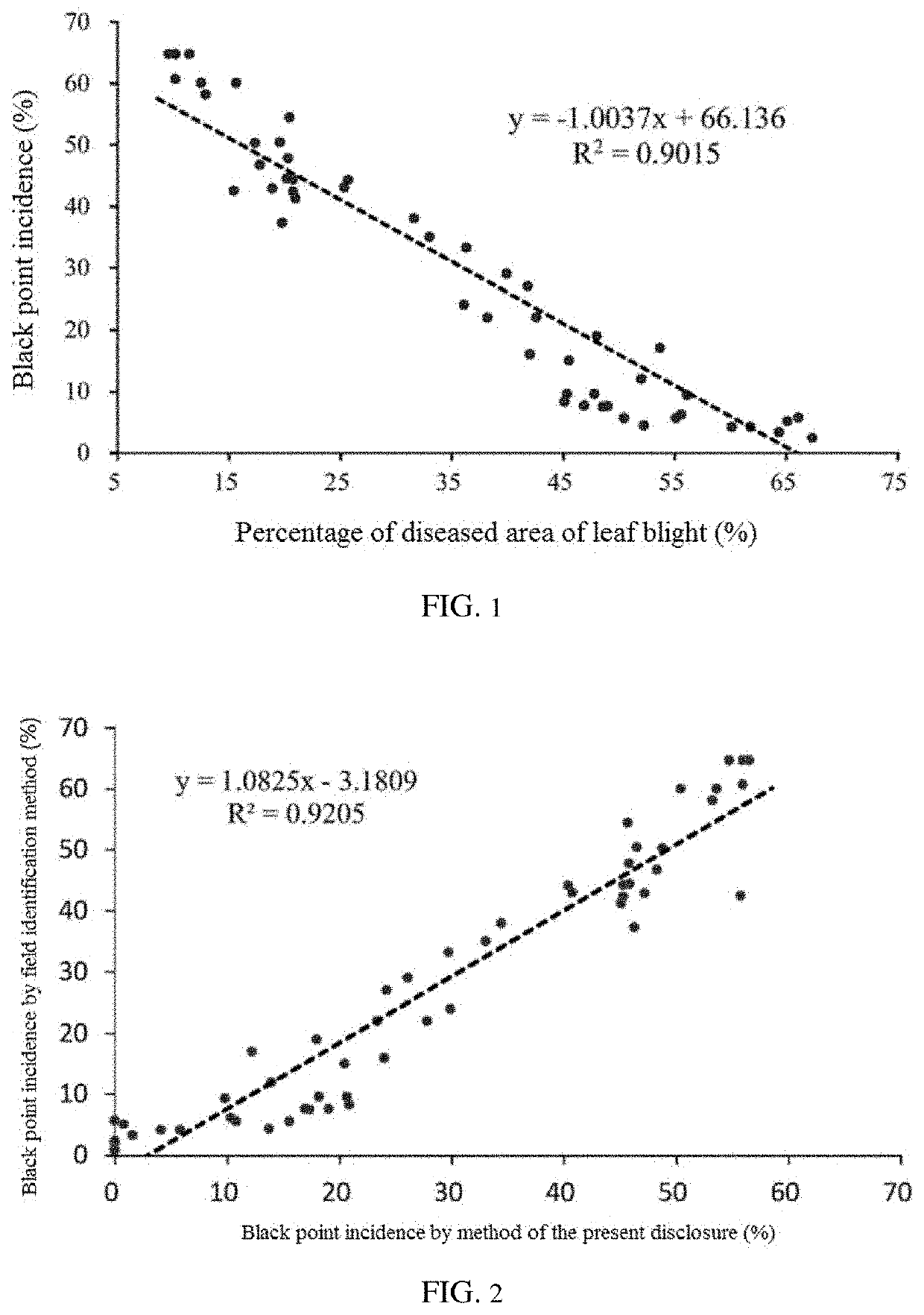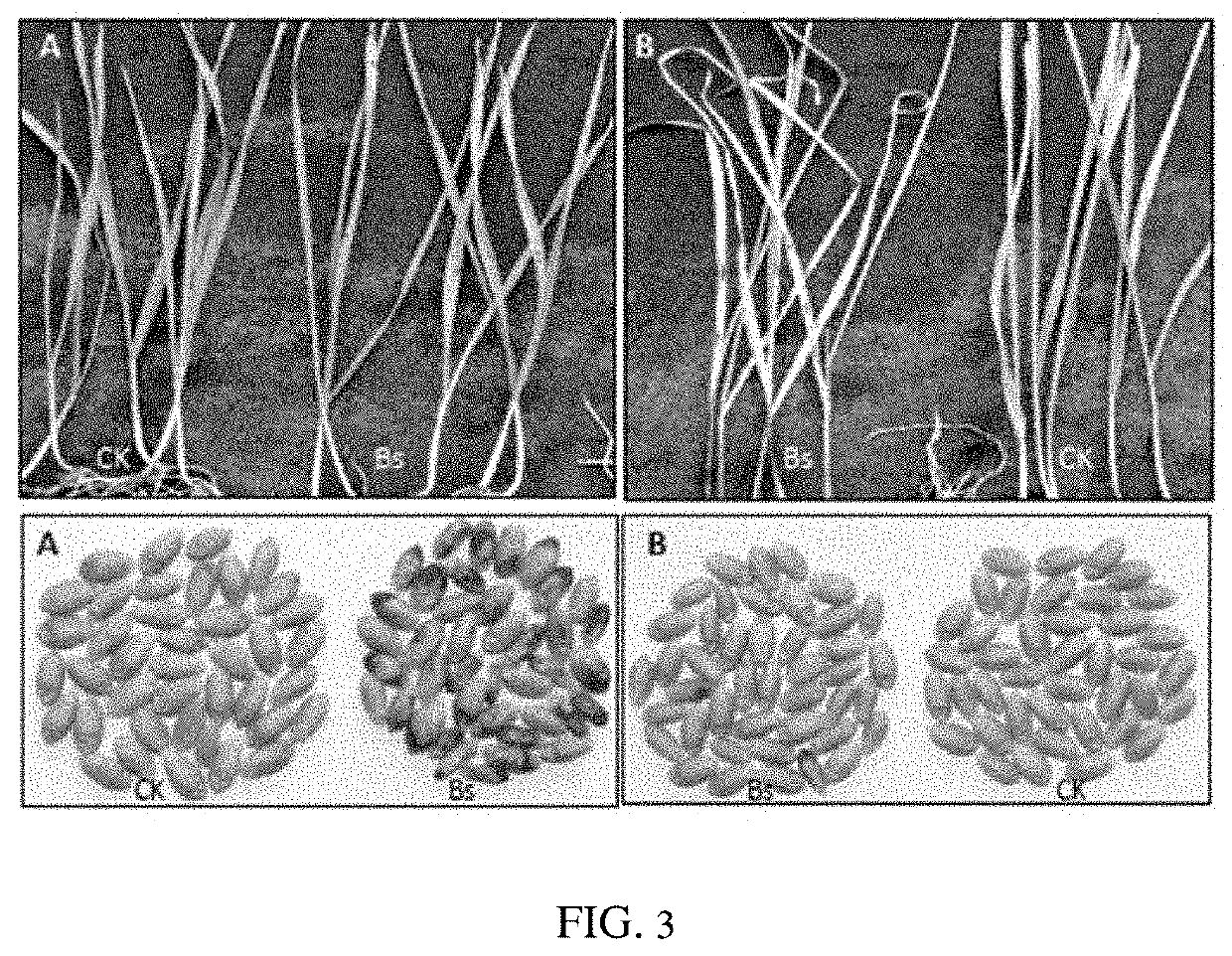Method for indoors and rapidly identifying the resistance of wheat to black point disease caused by bipolaris sorokiniana
a technology of bipolaris sorokiniana and resistance, applied in the field of crop disease detection, can solve the problems of affecting human health, affecting the emergence rate and seedling growth of seedlings, and the level of wheat acquisition, so as to shorten the identification time, simplify the identification procedure, and quickly identify the resistance of wheat to black point disease.
- Summary
- Abstract
- Description
- Claims
- Application Information
AI Technical Summary
Benefits of technology
Problems solved by technology
Method used
Image
Examples
example 1
[0058]In the winter of 2016, the method of the present disclosure for rapid indoor identification of the resistance of wheat to black point disease caused by Bipolaris sorokiniana was used to identify the resistance of 54 wheat cultivars or lines harvested in Xingyang to black point disease. The detailed steps are described as follows.
[0059]Surface sterilization of wheat seeds: healthy and full wheat seeds from 54 wheat cultivars or lines were selected and soaked in 70% (volume ratio) alcohol for 2 minutes, then the seeds were rinsed with sterilized distilled water for 3 times, and shaken gently for 5 seconds each time after adding distilled water, so that the alcohol remaining on the surface of the seeds was fully dissolved in the water to prevent the alcohol from inhibiting the germination of wheat seeds;
[0060]Wheat seedling cultivation: the wheat seeds that had been surface-sterilized in step a) were placed in Petri dishes with a diameter of 9 cm. To each Petri dish were added 2 ...
example 2
[0069]Ten (10) disease-resistant wheat cultivars / lines were identified for 3 consecutive years by using the method for quickly identifying wheat resistance to black point disease caused by B. sorokiniana in the present disclosure, and the results were compared with the field identification results.
[0070]The detailed steps are as follows
[0071]Surface sterilization of wheat seeds: healthy and full wheat seeds were selected and soaked in 70% (volume ratio) alcohol for 2 minutes, then the seeds were rinsed with sterilized distilled water for 3 times, and shaken gently for 5 seconds each time after adding distilled water, so that the alcohol remaining on the surface of the seeds was fully dissolved in the water to prevent the alcohol from inhibiting the germination of wheat seeds;
[0072]Wheat seedling cultivation: the wheat seeds that had been surface-sterilized in step a) were placed in Petri dishes with a diameter of 9 cm. Each Petri dish was added 2 layers of sterilized filter paper an...
example 3
[0082]By using the method for rapid indoor identification of the resistance of wheat to the black point disease caused by B. sorokiniana, two of ten advanced lines from the F4 and F5 were identified to be resistant lines in March 2018. Crossing was conducted in April 2018 in the field, and breeding efficiency is improved compared with field identification method. Cross breeding may be carried out one year earlier. The detailed steps are described as follows.
[0083]Surface sterilization of wheat seeds: healthy and full wheat seeds from 10 advanced F4 and F5 wheat lines were selected and soaked in 70% (volume ratio) alcohol for 2 minutes, then the seeds were rinsed with sterilized distilled water for 3 times, and shaken gently for 5 seconds each time after adding distilled water, so that the alcohol remaining on the surface of the seeds was fully dissolved in the water to prevent the alcohol from inhibiting the germination of wheat seeds;
[0084]Wheat seedling cultivation: the wheat seed...
PUM
| Property | Measurement | Unit |
|---|---|---|
| diameter | aaaaa | aaaaa |
| temperature | aaaaa | aaaaa |
| temperature | aaaaa | aaaaa |
Abstract
Description
Claims
Application Information
 Login to View More
Login to View More - R&D
- Intellectual Property
- Life Sciences
- Materials
- Tech Scout
- Unparalleled Data Quality
- Higher Quality Content
- 60% Fewer Hallucinations
Browse by: Latest US Patents, China's latest patents, Technical Efficacy Thesaurus, Application Domain, Technology Topic, Popular Technical Reports.
© 2025 PatSnap. All rights reserved.Legal|Privacy policy|Modern Slavery Act Transparency Statement|Sitemap|About US| Contact US: help@patsnap.com


